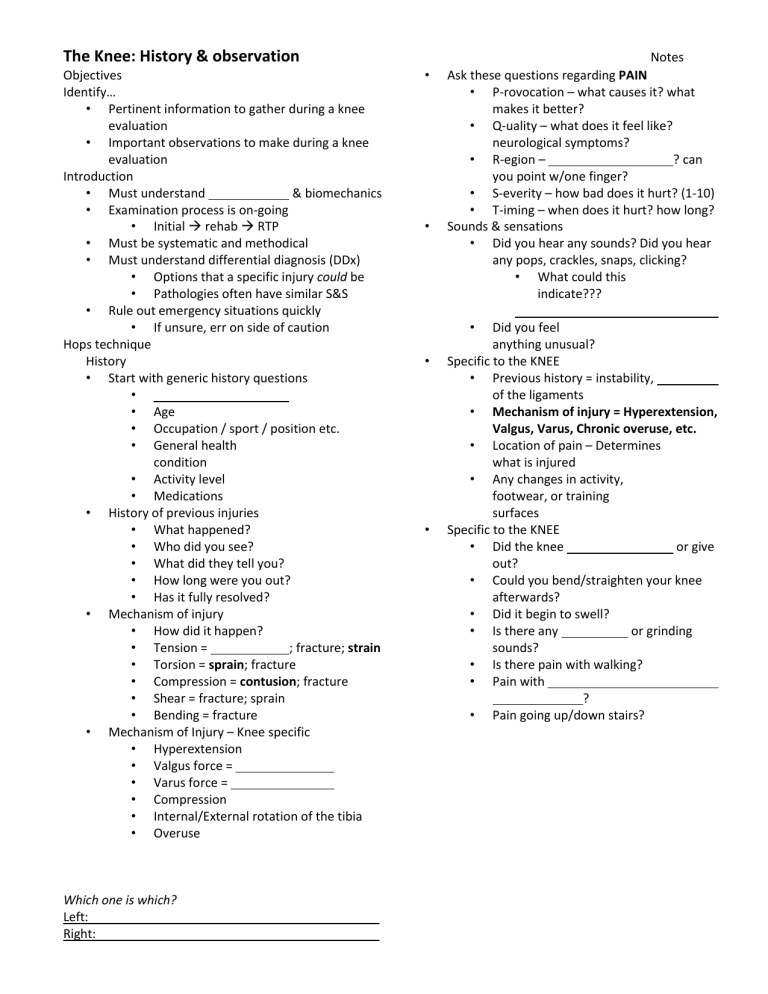Knee evaluation - Cloudfront.net

The Knee: History & observation
Objectives
Identify…
• Pertinent information to gather during a knee evaluation
• Important observations to make during a knee evaluation
Introduction
• Must understand
• Examination process is on-going
• Initial rehab RTP
& biomechanics
• Must be systematic and methodical
• Must understand differential diagnosis (DDx)
• Options that a specific injury could be
• Pathologies often have similar S&S
• Rule out emergency situations quickly
• If unsure, err on side of caution
Hops technique
History
• Start with generic history questions
•
• Age
• Occupation / sport / position etc.
• General health condition
• Activity level
• Medications
• History of previous injuries
• What happened?
• Who did you see?
• What did they tell you?
• How long were you out?
• Has it fully resolved?
• Mechanism of injury
• How did it happen?
• Tension = ; fracture; strain
• Torsion = sprain; fracture
• Compression = contusion; fracture
• Shear = fracture; sprain
• Bending = fracture
• Mechanism of Injury – Knee specific
• Hyperextension
• Valgus force =
• Varus force =
• Compression
• Internal/External rotation of the tibia
• Overuse
Which one is which?
Left:
Right:
Notes
• Ask these questions regarding PAIN
• P-rovocation – what causes it? what makes it better?
• Q-uality – what does it feel like? neurological symptoms?
• R-egion – ? can you point w/one finger?
• S-everity – how bad does it hurt? (1-10)
• T-iming – when does it hurt? how long?
• Sounds & sensations
• Did you hear any sounds? Did you hear any pops, crackles, snaps, clicking?
• What could this indicate???
• Did you feel anything unusual?
• Specific to the KNEE
• Previous history = instability, of the ligaments
• Mechanism of injury = Hyperextension,
Valgus, Varus, Chronic overuse, etc.
• Location of pain – Determines what is injured
• Any changes in activity, footwear, or training surfaces
• Specific to the KNEE
• Did the knee or give out?
• Could you bend/straighten your knee afterwards?
• Did it begin to swell?
• Is there any or grinding sounds?
• Is there pain with walking?
• Pain with
?
• Pain going up/down stairs?
The Knee: History & observation
Observation
• When does this begin?
• Compare each side bilaterally to identify what is normal for that person
We look for:
• Deformity, asymmetry, ,
ecchymosis
For the knee:
• Gait
• Half squatting
• Going up/down stairs
• Leg alignment
• Genu valgum – knocked knee’d
• Genu -
• Genu recurvatum – Hyperextension
• Patella alta – high patella
• Patella baja – low patella
• Squint eye patella – points
• Frog eye patella – points laterally
• Additional examinations:
• Q-angle – degree of alignment between anterior hip & tibia
• Leg Length
• Gait analysis
• Gross motor function
• Can the athlete move the limb on their own through normal function?
• Can the knee fully extend & fully flex compared bilaterally?
Notes
Critical thinking…
The starting catcher walks into the athletic training room complaining that he hears a clicking noise in his left knee every time he walks, runs, or bends his knee.
This clicking is causing him pain when he jogs/runs, and when he is just sitting in class. The pain appears on the anterior-lateral aspect of the knee, and has been getting worse over the last few days. You notice upon inspection that there is minor edema over the knee, but also that he cannot fully straighten his leg.
• What injury/injuries could this possibly be?
• What clues gave it away?




